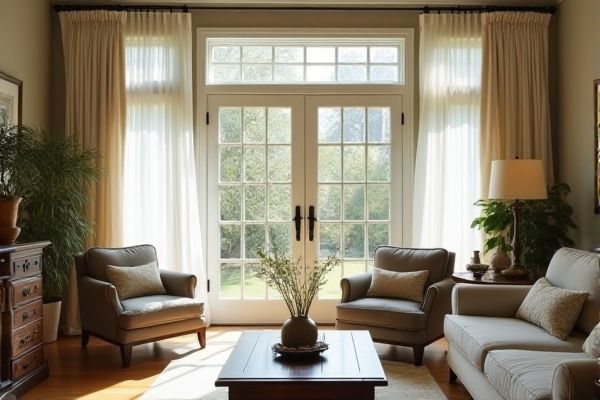
Blackout curtains provide maximum light blockage and privacy, ideal for controlling sunlight and heat in your sunroom, while sheer drapes offer a softer, diffused natural light that maintains an airy feel. Discover which option best suits your sunroom's style and functionality as you explore the benefits of blackout curtains versus sheer drapes in this article.
Table of Comparison
| Feature | Blackout Curtains | Sheer Drapes |
|---|---|---|
| Light Control | Blocks nearly 100% of sunlight | Filters sunlight, provides soft glow |
| Privacy | High privacy, blocks views from outside | Low to moderate privacy, silhouettes visible |
| Insulation | Improves thermal insulation, energy efficient | Minimal insulation, reduces glare |
| Material | Thick, opaque fabrics (polyester, cotton blends) | Lightweight, translucent fabrics (voile, chiffon) |
| Use in Sunroom | Ideal for darkening space, controlling heat and glare | Enhances natural light, softens harsh sunlight |
| Maintenance | Machine washable or dry clean options | Easy to wash, quick drying |
| Cost | Moderate to high | Low to moderate |
Introduction: Choosing Sunroom Window Treatments
Blackout curtains provide complete light blockage and enhanced privacy, making them ideal for controlling sunlight and maintaining comfort in your sunroom. Sheer drapes offer a soft diffusion of natural light while preserving outdoor views, perfect for creating an airy, bright atmosphere. Your choice depends on whether you prefer maximum light control and insulation or a gentle, translucent ambiance.
What Are Blackout Curtains?
Blackout curtains are specially designed window coverings made from densely woven or layered fabrics that block out nearly 100% of sunlight, making them ideal for sunrooms where controlling light and heat is essential. These curtains provide superior privacy, reduce glare, and enhance energy efficiency by insulating against heat and cold. Unlike sheer drapes, blackout curtains create a darkened environment, perfect for daytime naps or protecting furniture from sun damage.
What Are Sheer Drapes?
Sheer drapes are lightweight, translucent window coverings that allow natural sunlight to filter through while providing a level of privacy in a sunroom. Unlike blackout curtains that block out light completely, sheer drapes soften harsh sunlight and reduce glare without darkening the space. They are ideal for maintaining an airy, bright atmosphere while protecting furniture and flooring from UV damage.
Light Control: Blackout vs Sheer
Blackout curtains provide superior light control by completely blocking sunlight, creating a darkened environment ideal for sunrooms requiring privacy or temperature regulation. Sheer drapes allow natural light to filter through while diffusing harsh rays, maintaining a bright, airy atmosphere without compromising visibility. Choosing between blackout and sheer depends on the desired balance between light reduction and ambient illumination in the sunroom.
Privacy Considerations in a Sunroom
Blackout curtains provide maximum privacy in a sunroom by completely blocking visibility from outside, making them ideal for spaces requiring seclusion. Sheer drapes allow natural light while offering minimal privacy, which may not be suitable if you want to prevent outsiders from seeing inside. Your choice should balance privacy needs with desired light levels, with blackout curtains offering superior coverage compared to the translucent nature of sheer drapes.
Energy Efficiency and Insulation Benefits
Blackout curtains provide superior energy efficiency by blocking sunlight and significantly reducing heat transfer, helping to maintain a consistent temperature in your sunroom year-round. Sheer drapes allow natural light to filter through but offer minimal insulation, resulting in higher energy costs during extreme temperatures. Choosing blackout curtains maximizes insulation benefits, reducing reliance on heating and cooling systems while enhancing comfort.
Aesthetic Impact on Sunroom Décor
Blackout curtains create a bold, dramatic aesthetic in a sunroom by providing complete light blockage and strong color or pattern statements that complement modern or minimalist decor. Sheer drapes contribute a soft, airy ambiance, enhancing natural light diffusion and promoting a relaxed, elegant atmosphere ideal for traditional or coastal-style interiors. Combining both materials allows for versatile light control while maintaining layered depth and texture in sunroom decor.
Maintenance and Cleaning Comparison
Blackout curtains require less frequent cleaning due to their dense fabric that resists dust and light, making them ideal for low-maintenance sunroom use. Sheer drapes, however, demand more regular washing to keep their delicate, translucent fabric looking fresh and free of dust or allergens. You can extend the life of both by following manufacturer care instructions, but blackout curtains generally offer easier upkeep in sunny, dusty environments.
Cost Breakdown: Blackout Curtains vs Sheer Drapes
Blackout curtains typically cost between $30 to $150 per panel, offering superior light-blocking capabilities and energy efficiency, while sheer drapes range from $20 to $70 per panel, providing softer light diffusion and aesthetic appeal at a lower price point. Installation costs for blackout curtains may be higher due to heavier materials and specialized mounting hardware, whereas sheer drapes are lighter and easier to install with standard curtain rods. Maintenance expenses for blackout curtains can involve more frequent cleaning to preserve their opacity, whereas sheer drapes require gentler care to maintain fabric integrity, influencing long-term cost considerations for sunroom window treatments.
Making the Best Choice for Your Sunroom
Choosing between blackout curtains and sheer drapes for a sunroom depends on your desired light control and privacy level. Blackout curtains effectively block sunlight and reduce heat, ideal for creating a cozy, darkened space, while sheer drapes allow natural light to filter through, maintaining brightness and an airy atmosphere. Consider your sunroom's primary use and climate to make the best choice that balances comfort, energy efficiency, and aesthetic appeal.
 homyna.com
homyna.com